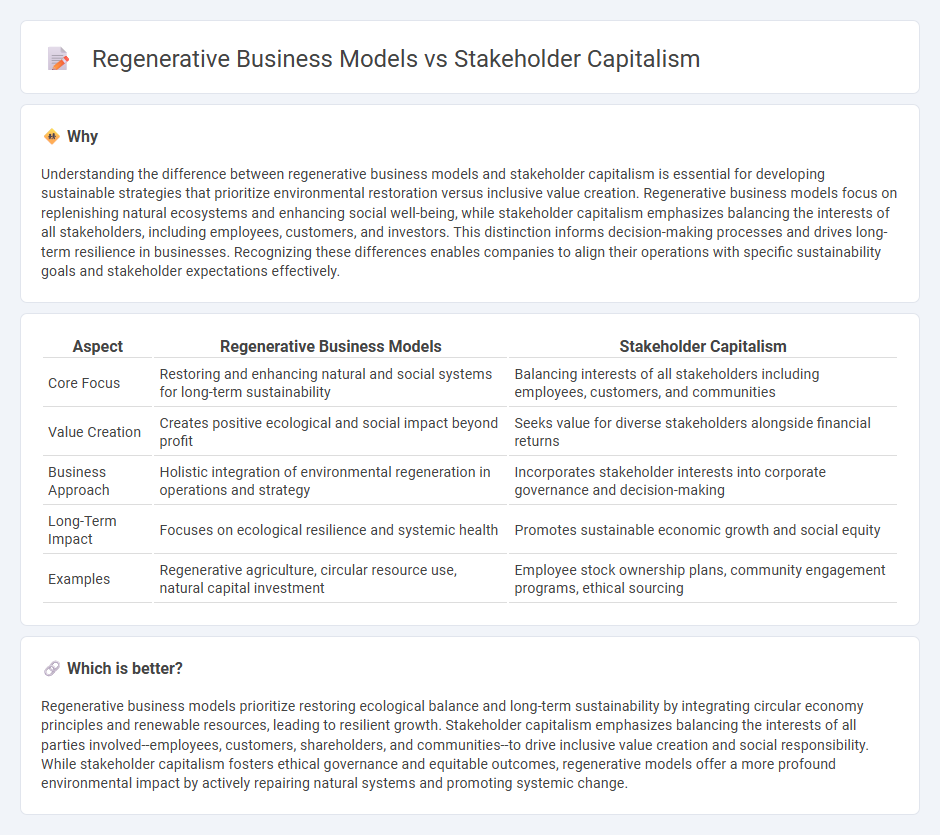
Regenerative business models focus on restoring and renewing ecosystems, communities, and economies through sustainable practices that create long-term value for all stakeholders. Stakeholder capitalism emphasizes balancing the interests of shareholders, employees, customers, and society to achieve inclusive growth and ethical governance. Explore how consulting firms help organizations transition from traditional stakeholder capitalism to regenerative business models for resilient, future-ready strategies.
Why it is important
Understanding the difference between regenerative business models and stakeholder capitalism is essential for developing sustainable strategies that prioritize environmental restoration versus inclusive value creation. Regenerative business models focus on replenishing natural ecosystems and enhancing social well-being, while stakeholder capitalism emphasizes balancing the interests of all stakeholders, including employees, customers, and investors. This distinction informs decision-making processes and drives long-term resilience in businesses. Recognizing these differences enables companies to align their operations with specific sustainability goals and stakeholder expectations effectively.
Comparison Table
| Aspect | Regenerative Business Models | Stakeholder Capitalism |
|---|---|---|
| Core Focus | Restoring and enhancing natural and social systems for long-term sustainability | Balancing interests of all stakeholders including employees, customers, and communities |
| Value Creation | Creates positive ecological and social impact beyond profit | Seeks value for diverse stakeholders alongside financial returns |
| Business Approach | Holistic integration of environmental regeneration in operations and strategy | Incorporates stakeholder interests into corporate governance and decision-making |
| Long-Term Impact | Focuses on ecological resilience and systemic health | Promotes sustainable economic growth and social equity |
| Examples | Regenerative agriculture, circular resource use, natural capital investment | Employee stock ownership plans, community engagement programs, ethical sourcing |
Which is better?
Regenerative business models prioritize restoring ecological balance and long-term sustainability by integrating circular economy principles and renewable resources, leading to resilient growth. Stakeholder capitalism emphasizes balancing the interests of all parties involved--employees, customers, shareholders, and communities--to drive inclusive value creation and social responsibility. While stakeholder capitalism fosters ethical governance and equitable outcomes, regenerative models offer a more profound environmental impact by actively repairing natural systems and promoting systemic change.
Connection
Regenerative business models prioritize environmental restoration and social equity, aligning closely with stakeholder capitalism's focus on creating value for all stakeholders, including employees, communities, and the environment. Both frameworks emphasize long-term sustainability over short-term profits by integrating ecological health and social well-being into core business strategies. This interconnected approach drives innovation, resilience, and inclusive growth across industries.
Key Terms
Stakeholder Engagement
Stakeholder capitalism prioritizes the interests and involvement of all parties impacted by a company's operations, fostering transparent communication and collaborative decision-making processes. Regenerative business models extend this approach by actively restoring and enhancing social and environmental systems through innovative practices and long-term value creation. Explore how effective stakeholder engagement drives sustainable growth and resilience in modern enterprises.
Circular Economy
Stakeholder capitalism emphasizes balancing the interests of all parties involved in a business, while regenerative business models prioritize restoring and enhancing natural systems through sustainable practices. The Circular Economy, a core component of regenerative models, minimizes waste by promoting reuse, recycling, and resource efficiency across product lifecycles, driving both environmental and economic benefits. Discover how integrating Circular Economy principles transforms stakeholder capitalism into a powerful force for sustainable growth.
ESG (Environmental, Social, Governance)
Stakeholder capitalism prioritizes value creation for all stakeholders including employees, customers, and communities by integrating ESG (Environmental, Social, Governance) criteria into business strategies to promote sustainability and social responsibility. Regenerative business models go further by actively restoring and enhancing natural and social ecosystems, embedding circular economy principles that reduce environmental impact and drive long-term resilience. Discover how these approaches can redefine corporate success and contribute to a sustainable future.
Source and External Links
Shareholder Capitalism and Stakeholder Capitalism: Commonalities and Differences - Edward A. Snyder - Stakeholder capitalism is a model where firms focus on a broad set of objectives including employees, customers, and society, contrasting with shareholder capitalism which prioritizes shareholder profits; however, if shareholder firms consider social responsibility for financial gains, the models share substantial commonalities.
What is stakeholder capitalism? It's History and Relevance - World Economic Forum - Stakeholder capitalism is a form of capitalism that seeks long-term value creation by accounting for the needs of all stakeholders, including people and the planet, aiming for harmonious outcomes beyond mere profit or national prosperity.
What Does "Stakeholder Capitalism" Mean to You? - Harvard Business Review - Stakeholder capitalism is an emerging and inclusive form of capitalism where companies adopt a multistakeholder governance approach to strengthen companies, improve stakeholder outcomes, and produce better long-term shareholder returns.
 dowidth.com
dowidth.com